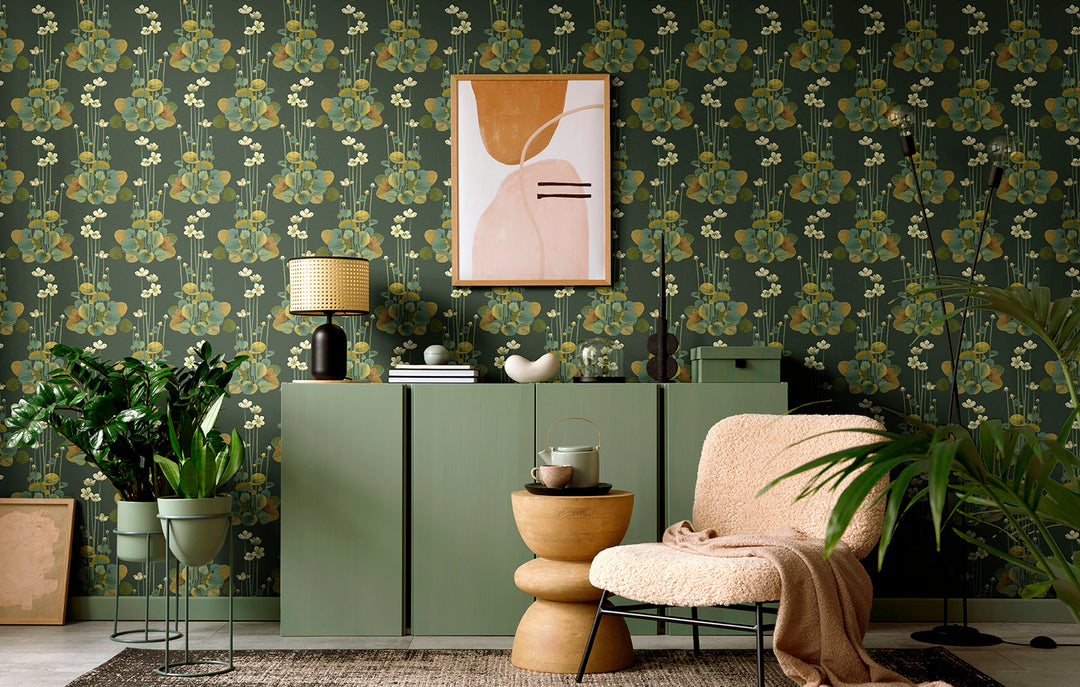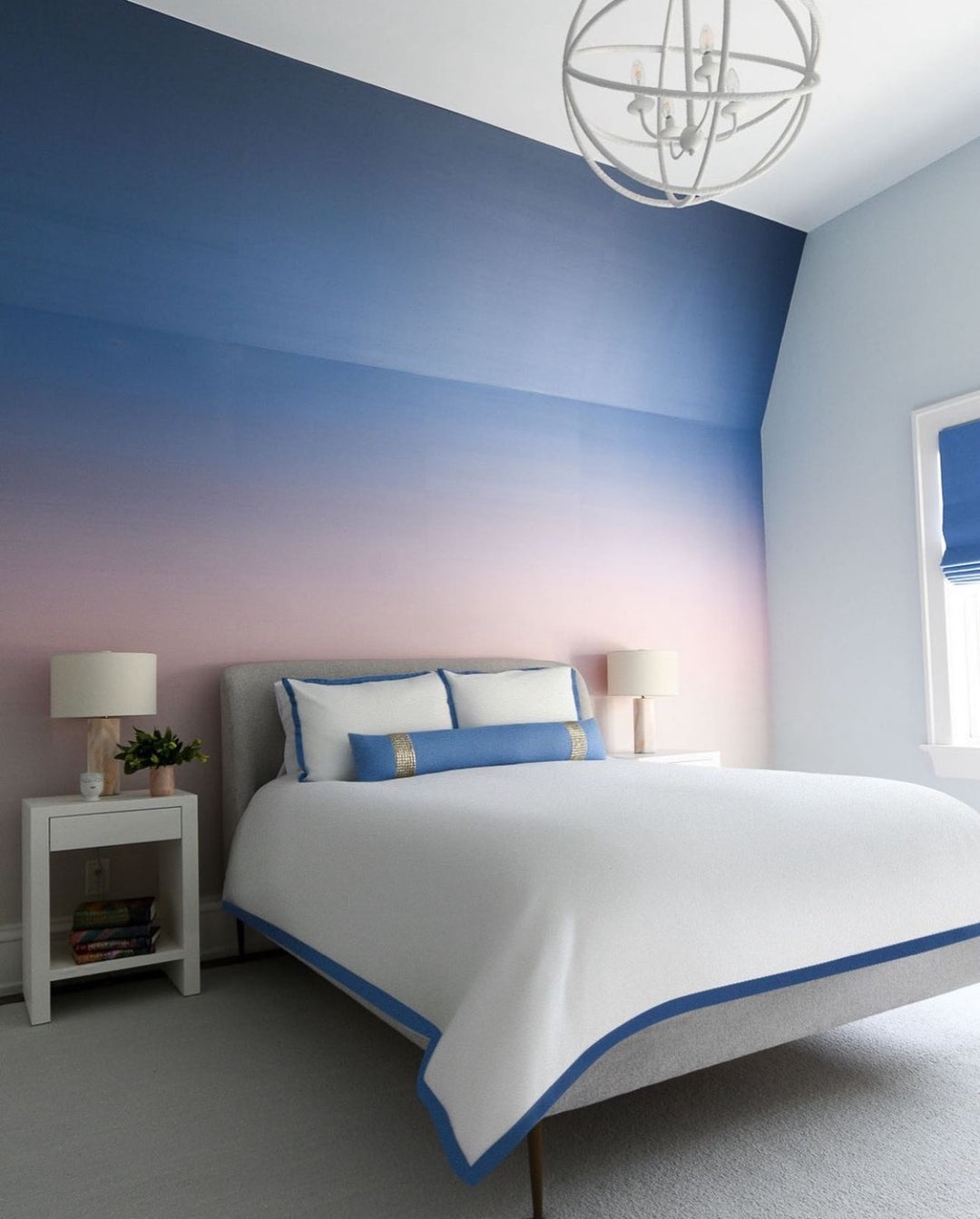How To Install Wallpaper That Requires Paste
BEFORE YOU GET STARTED
Installing traditional wallpaper that requires paste may be a straightforward process, but as any professional wallpaper installer will tell you, it is also an art. We recommend that our wallpaper that requires paste be professionally installed, but if you prefer, you may undertake the installation yourself.
Additionally, we offer a peel & stick option for non-permanent, easier DIY installations.
Here's a step-by-step guide to help you install our wallpaper that requires paste:
TOOLS YOU WILL WANT TO HAVE ON HAND:
- Ladder
- Level with a straight edge
- Pencil
- Wallpaper brush
- Drywall taping knife
- Scissors
- Utility blade
- Roller brush
- Microfiber cloth
- Seam roller
- Helper (Recommended)
- Spackle (If Needed)
- Sandpaper (Optional)
- Painter’s tarp (Optional)
- Painter’s tape (Optional)
PREPARING YOUR WALLS:
Every great journey begins with one small step. And when it comes to hanging wallpaper, the first step is one of the most important. Wallpaper can't cling to greasy, dirty walls, old wallpaper or peeling paint. That's why we can't emphasize enough how critical it is to have your walls properly prepared.
Clean Wall Surface
Surfaces coated with flat (non-gloss) paint should be scraped (if old and flaking), sanded smooth and washed with an all-purpose cleaner. Walls covered with high- or semi-gloss paint should be sealed with an acrylic primer. In rooms where mildew occurs, wash the wall with a mixture of bleach and water first.
Sanitize
Mildew can show up on walls as a yellow, green, gray or black colored area. If this occurs, wash walls with a concentrated solution of one cup bleach and one gallon of hot water. Apply with a paint brush and let sit for one hour. Rinse with warm water, let dry and coat with alkyd primer/sealer. All professional priming and sealing products should be mildew-resistant and will keep the problem from reoccurring if all fungus is removed prior to hanging. Check the label before buying to be sure.
Sizing and Primer
One-step primer/sealers have all but eliminated the need for wall sizing. A coat of acrylic primer provides a new, even surface on the wall which makes it easier to slide wallcoverings into position. It also prevents the wall itself from absorbing moisture, which protects against future damage. Alkyd (oil) primers are equally, if not more, effective. However, an acrylic primer or regular sizing should also be used over the alkyd primer to provide adequate slippage. This step should be done in advance to allow primer to cure for at least 48 hours.
Older Wall Surfaces
Existing walls need special attention. Paint can create problems based upon its original quality or how long it has been on the wall. If it's old, paint can become unstable and should be sealed with primer/sealer to insure a successful wallcovering installation.
Wall Defects
Nail holes, chips, cracks and wall irregularities should be filled with vinyl spackling compound before primer is applied. Use a broad knife to apply spackle right from the can. Force the compound well into the hole and smooth the surface. When the compound dries, sand, smooth and seal the wall with a primer.
Extra Attention
Heavy-duty lining paper serves as a versatile solution for evening the surface of heavily textured walls, while also effectively bridging gaps and cracks on problematic walls. This cost-effective method provides a smooth, porous surface that enhances adhesion by absorbing excess moisture. Ensure the paper is allowed to dry thoroughly (approximately 36 hours) before applying two coats of white primer/sealer and continuing with your DWC wallcovering.
Depending on the wall type, additional preparatory work may be necessary:
For Textured Walls:
Floating the Walls: Apply joint compound evenly over the rough walls using a broad knife. Once the desired smoothness is achieved, allow it to dry before priming with two coats of primer/sealer.
Sanding: If the texture is minimal, sanding can be sufficient. After sanding, apply primer/sealer. Note that this method generates dust and is labor-intensive, making it the least preferred option.
For Hanging Lining Paper:
Fill holes and cracks with joint compound, chip off any high points with a broad knife, and lightly sand the wall surface to even it out. Prime the wall and let it dry completely. Apply heavy-duty adhesive to the lining paper and paste both the wall surface and the back of the lining paper for better adhesion. Once the lining paper is dry, apply a primer/sealer.
For Wood-Paneled Walls:
Wash the walls thoroughly with a deglossing solution and water, then sand them smooth. Fill vertical grooves with spackle and apply primer or apply primer directly and hang heavy-duty lining paper. Seal with acrylic primer, allow it to cure, and hang the desired wallcovering.
Stripping Old Wallpaper
Most wallcoverings are strippable and easy to remove. However, if you're having difficulty, your wallpaper can be soaked with wallpaper remover using a large sponge, spray bottle or roller. If your paper is non-porous, score the wallcovering with a "paper tiger." After stripping paper, wash walls with a cleaner and apply primer.
If you prefer to paper over an existing wallcovering, make sure it is firmly attached to the wall and is as smooth as possible. Cut an "X" in any bubbles and tear the loose pieces away, feathering the edges. Sand seams and glue down any curling corners with seam adhesive. Finally, seal the existing wall with white acrylic primer.
New Construction
For new drywall, gypsum wallboard or other porous surfaces that have never been sealed or painted, apply two coats of alkyd primer. This assures that the paper will be strippable. When the alkyd primer is dry, apply one coat of clear acrylic primer and let dry (2 hours) before hanging wallpaper.
Special Situations
Even if your walls are covered in plastic paneling, vinyl, Formica or glass, you can still apply wallcoverings. Just wash the surface with an all-purpose cleaner and apply a coat of acrylic wall primer.
INSTALLING YOUR WALLPAPER:
Cut wallpaper strips to cover the vertical length of your wall(s), leaving an additional 4 inches of excess for top and bottom trimming. If using pre-pasted wallpaper, activate the adhesive as per instructions. If using separate adhesive, follow the provided instructions.
Place Your Paper:
Carefully apply the first strip of wallpaper, ensuring it is straight as it will serve as the reference for subsequent pieces. Have a helper assist in holding and aligning the wallpaper. Use a wallpaper brush to remove bubbles and ensure proper adhesion. Trim excess paper as needed.
Using broad smooth strokes work excess paste and trapped air from center out left and right until panel is smooth. Avoid burnishing the face of the material. Use a wallcovering brush or a plastic scraper to gently smooth the wallcovering onto the wall.
Repeat process with consecutive panels. Butt edges tightly at the pattern match without overlapping. Cut ceiling and floor cuts before moving to next panel.
Do not rub. Do not allow the adhesive to remain on surface as it may leave a white residue or cause ink to lift. Wash off excess paste from face of wall covering immediatly as you hang it with a cellulose sponge. The cellulose sponge must be rinsed in clean water after every use. Water discoloration is normal and expected. Blot dry with a clean cloth. No scrubbing, abrasive or solvent cleaners. Use seam roller to make sure all seams are bonded well.
After three panels are smoothed to wall surface and excess paste removed, examine the installed panels for color uniformity. Any objectionable variations in color match, pattern match, etc....should be immediately communicated to DWC for inspection before proceeding further with installation.
After installation is complete, minor blisters like small bubbles may be present. Please allow 7 days for adhesive to fully cure. As wallpaper cures it will tighten like a drum and pull taught any minor blisters. Do not try to press them down with your finger. The walls and wallcovering should be monitored for potential moisture or vapor infiltration or accumulation. Any such infiltration/accumulation after installation must be promptly eliminated in order to reduce the risk of mold/mildew growth.
Corners, Outlets, Windows, Doors, etc.:
Manage interior corners by overlapping wallpaper sections for a tight fit. For outlets and switches, turn off power, remove covers, cut holes, and reattach covers once wallpaper is in place. Trim wallpaper around windows and doors for a precise fit after adjoining seams are matched and seam rolled down securely.
Clean Up:
Tidy up any excess adhesive or debris. Use fresh clean warm water and a microfiber cloth to gently wash all areas that may have come into contact with paste at any point during the installation process. Any dirty paste water that is allowed to dry on the wallpaper surface may leave a dull residue. This final process must be thorough and gentle. Do not scrub the wallpaper surface at any time.
Celebrate:
Congratulations on completing the installation! Take a moment to celebrate your newly wallpapered space.
PRO TIPS:
Use sharp scissors and new utility blades for accurate cuts.
Change blade often.
Utilize a level for precise planning and alignment.
Enlist the help of a friend for efficiency and accuracy during installation.
Use slow, smooth motions when applying wallpaper to avoid wrinkles or shifting the seam.
Address bubbles by gently smoothing them towards the edge of the wallpaper.
Use painter’s tape to protect areas from unwanted adhesive.
For any other concerns you may have







